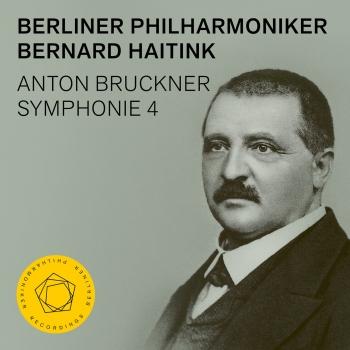
Mahler: Symphony No. 9 Berliner Philharmoniker & Bernard Haitink
Album info
Album-Release:
2020
HRA-Release:
30.04.2021
Label: Berlin Philharmonic Orchestra
Genre: Classical
Subgenre: Orchestral
Artist: Berliner Philharmoniker & Bernard Haitink
Composer: Gustav Mahler (1860-1911)
Album including Album cover Booklet (PDF)
- Gustav Mahler (1860 - 1911): Symphony No. 9:
- 1 Symphony No. 9: I. Andante comodo 31:06
- 2 Symphony No. 9: II. Im Tempo eines gemächlichen Ländlers. Etwas täppisch und sehr derb 17:21
- 3 Symphony No. 9: III. Rondo-Burleske. Allegro assai. Sehr trotzig 15:21
- 4 Symphony No. 9: IV. Adagio 25:49
Info for Mahler: Symphony No. 9
It is almost inconceivable today that Gustav Mahler’s works were long marginalised in musical life. Bernard Haitink, who has an exceptionally fine feel for the fragmented nature of this music, is one of the conductors who brought about the Mahler renaissance in the 1960s. Mahler, says Haitink, “has always troubled me because he doesn’t validate you”. In this concert, he conducts Mahler’s farewell to the world, the Ninth Symphony.
This Gustav Mahler edition brings together Berliner Philharmoniker recordings from the last ten years. It includes the nine completed symphonies and the Adagio of the Tenth, whose performance under the direction of Claudio Abbado on the 100th anniversary of Mahler’s death is one of the highlights. In addition to chief conductor Kirill Petrenko and his predecessor Sir Simon Rattle, the edition features other outstanding Mahler interpreters closely associated with the orchestra: Gustavo Dudamel, Bernard Haitink, Daniel Harding, Andris Nelsons and Yannick Nézet-Séguin.
When Bernard Haitink was appointed chief conductor of the Concertgebouw Orchestra in 1961, the Mahler tradition in the Netherlands, begun by Willem Mengelberg, had long since faded as a result of Nazi dictatorship and World War II: “He [Mahler] was forbidden in my country until 1945. [...] There was no more Mahler tradition, and the music was really new. I remember that Erich Kleiber performed the Third. But that was much later.” Despite this background, Bernard Haitink made a significant contribution to the Mahler renaissance which began in the early 1960s and which earned him the reputation of an outstanding Mahler conductor: “Mahler”, he says, “has always troubled me because he doesn’t validate you.”
A partner of the Berliner Philharmoniker for many years, the Dutch maestro now conducts Mahler’s Ninth Symphony, a work of an exceptional nature: even Bruno Walter described the first movement of Mahler’s last completed symphony as “a tragically harrowing, and noble paraphrase of that feeling of farewell”. In the second movement, we then hear shadowy forms of a variety of dance modes, described by Dieter Schnebel as ʻcomposed ruinsʼ. The brittle music, which sometimes takes on demonically grotesque characteristics, culminates in a wild “Danse macabre”, in which the violins – like the solo violin in the Totentanz Scherzo of the Fourth – have to play “like fiddles”. This is followed by a Rondo-Burleske of agitated bustle whose raging tornado “takes the mild irony of the Fischpredigt Scherzo from the Second Symphony and raises it to a level that is barely tolerable” (Jens Malte Fischer). The finale, with its characteristic turn motif, offers no apotheosis. Instead, what is heard is an expansively sung Adagio which employs “his whole arsenal of vocables expressive of grief from Mahler’s tonal language” (Hans Heinrich Eggebrecht). The final part, played only by strings “with heart-felt emotion”, ends in a dying ritardando.
No wonder that the key analyses of the symphony since the posthumous premiere have revolved around concepts such as “farewell” and “death”. Given the many emotional moments, according to Haitink, the work offers great challenges: “For Mahler, it is important that you get the dynamic nuances right, so that not everything is a hotch-potch in mezzo forte. [...] Karajan once said that there is only one climax in a piece, and how important it is not to use all your ammunition at once. So you have to pace yourself [...].”
Berliner Philharmoniker
Bernard Haitink, conductor
Bernard Haitink
Bernard Haitink’s conducting career began 60 years ago with the Radio Philharmonic Orchestra in his native Holland. He went on to be Chief Conductor of the Concertgebouw Orchestra for 27 years, as well as Music Director of Glyndebourne Festival Opera, The Royal Opera, Covent Garden, and Principal Conductor of the London Philharmonic, the Staatskapelle Dresden and the Chicago Symphony Orchestra. He is Patron of the Radio Philharmonic, and Conductor Emeritus of the Boston Symphony, as well as an honorary member of both the Berlin Philharmonic and the Chamber Orchestra of Europe.
The 2014/15 season began with an anniversary concert with the Radio Philharmonic in the Concertgebouw, and will include return visits to the Symphony Orchestra of the Bayerischer Rundfunk, opening their season with the Missa Solemnis, four programmes with the London Symphony Orchestra in London, Madrid and Paris, and the conclusion of a Brahms cycle with the Chamber Orchestra of Europe in Amsterdam and Paris. He also conducts the Berlin Philharmonic in the Baden-Baden Easter Festival, and revisits the Chicago and Boston Symphony Orchestras.
He is committed to the development of young musical talent, and gives an annual Conducting Masterclass at the Lucerne Easter Festival. This season in addition he gives conducting classes to students of the Hochschule der Kunst, Zurich in collaboration with the Musikkollegium Winterthur, and a workshop with students from the Guildhall School of Music and Drama in conjunction with players from the London Symphony Orchestra.
Bernard Haitink has an extensive discography for Phillips, Decca and EMI, as well as the many new live recording labels established by orchestras themselves in recent years, such as the London Symphony, Chicago Symphony and Bayerischer Rundfunk. He has received many awards and honours in recognition of his services to music, including several honorary doctorates, an honorary Knighthood and Companion of Honour in the United Kingdom, and the House Order of Orange-Nassau in the Netherlands.
Booklet for Mahler: Symphony No. 9













